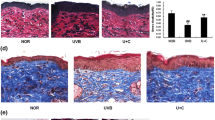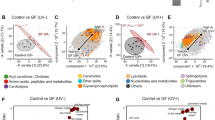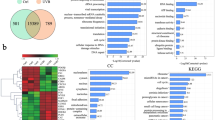Abstract
Introduction
While green tea is known to protect skin from ultraviolet (UV) light, underlying damage-repair mechanisms remain unclear.
Objectives
The major objective of this study was to investigate, using multi-omics analysis, the metabolic mechanisms associated with the effects of a diet supplemented with green tea (SGT) in UVB-damaged mice.
Methods
Six to eight weeks old female Skh:HR-1 mice were randomly divided into three experimental groups i.e., non-irradiated with control diet (NOR), UVB-irradiated with control diet (UND), and UVB-irradiated with SGT (UGD), and subjected to experimental conditions over 10 weeks. The skin samples were analyzed by metabolomics, transcriptomics, and in silico modeling.
Results
Our results revealed that SGT significantly alleviated UVB-induced metabolite alterations (aspartic acid, ornithine, ascorbic acid, ethanolamine, and C20:0-lysophosphatidylethanolamine) and gene expressions (keratin sulfate biosynthesis/degradation, fatty acid oxidation, and steroid metabolism) in the skin. Among these changes, key metabolic pathways, including ascorbate metabolism and the urea cycle, were the major pathways mitigated through SGT diet among UGD group mice. Additionally, SGT treatment also affected serum and hepatic lysophospholipid levels through attenuating and intensifying UVB-induced metabolic changes, respectively.
Conclusion
Our results suggested that the SGT diets primarily influenced ascorbate metabolism and the urea cycle in UVB-irradiated mouse skin, alleviating deleterious UVB-induced skin wrinkles, epidermal thickening, and collagen-fiber destruction.




Similar content being viewed by others
References
Åkesson, M., Förster, J., & Nielsen, J. (2004). Integration of gene expression data into genome-scale metabolic models. Metabolic Engineering, 6(4), 285–293.
Benjamini, Y., & Hochberg, Y. (1995). Controlling the false discovery rate: a practical and powerful approach to multiple testing. Journal of the Royal Statistical Society. Series B (Methodological), 289–300.
Björklund, S., Engblom, J., Thuresson, K., & Sparr, E. (2013). Glycerol and urea can be used to increase skin permeability in reduced hydration conditions. European Journal of Pharmaceutical Sciences, 50(5), 638–645.
Boccio, P., Rossi, C., Ioia, M., Cicalini, I., Sacchetta, P., & Pieragostino, D. (2016). Integration of metabolomics and proteomics in multiple sclerosis: From biomarkers discovery to personalized medicine. Proteomics Clinical Applications, 10(4), 470–484.
Debats, I. B. J. G., Wolfs, T. G. A. M., Gotoh, T., Cleutjens, J. P. M., Peutz-Kootstra, C. J., & Van der Hulst, R. R. W. J. (2009). Role of arginine in superficial wound healing in man. Nitric oxide: biology and chemistry/official journal of the Nitric Oxide Society, 21(3), 175–183.
Draelos, Z. D. (2010). Nutrition and enhancing youthful-appearing skin. Clinics in Dermatology, 28(4), 400–408.
Elmets, C. A., & Athar, M. (2010). Targeting ornithine decarboxylase for the prevention of nonmelanoma skin cancer in humans. Cancer Prevention Research, 3(1), 8–11.
Goerz, G., Barnstorf, W., Winnekendonk, G., Bolsen, K., Fritsch, C., Kalka, K., et al. (1996). Influence of UVA and UVB irradiation on hepatic and cutaneous P450 isoenzymes. Archives of Dermatological Research, 289(1), 46–51.
Grether-Beck, S., Felsner, I., Brenden, H., Kohne, Z., Majora, M., Marini, A., et al. (2012). Urea uptake enhances barrier function and antimicrobial defence in humans by regulating epidermal gene expression. Journal of Investigative Dermatology, 132(6), 1561–1572.
Hung, N. D., Sok, D. E., & Kim, M. R. (2012). Prevention of 1-palmitoyl lysophosphatidylcholine-induced inflammation by polyunsaturated acyl lysophosphatidylcholine. Inflammation Research, 61(5), 473–483.
Hyötyläinen, T., Jerby, L., Petäjä, E. M., Mattila, I., Jäntti, S., Auvinen, P., et al. (2016). Genome-scale study reveals reduced metabolic adaptability in patients with non-alcoholic fatty liver disease. Nature Communications, 7.
Ippolito, J. E., Xu, J., Jain, S., Moulder, K., Mennerick, S., Crowley, J. R., et al. (2005). An integrated functional genomics and metabolomics approach for defining poor prognosis in human neuroendocrine cancers. Proceedings of the National Academy of Sciences of the United States of America, 102(28), 9901–9906.
Joyce, A. R., & Palsson, B. Ø (2006). The model organism as a system: Integrating’omics’ data sets. Nature Reviews Molecular Cell Biology, 7(3), 198–210.
Jung, E. S., Park, H. M., Lee, K. E., Shin, J. H., Mun, S., Kim, J. K., et al. (2015). A metabolomics approach shows that catechin-enriched green tea attenuates ultraviolet B-induced skin metabolite alterations in mice. Metabolomics, 11(4), 861–871.
Katagiri, C., Sato, J., Nomura, J., & Denda, M. (2003). Changes in environmental humidity affect the water-holding property of the stratum corneum and its free amino acid content, and the expression of filaggrin in the epidermis of hairless mice. Journal of Dermatological Science, 31(1), 29–35.
Kobayashi, K., Ishizaki, Y., Shosuke, K. O. J. O., & Kikuzaki, H. (2016). Strong inhibition of secretory sphingomyelinase by catechins, Particularly by (–)-epicatechin 3-O-gallate and (–)-3′-O-methylepigallocatechin 3-O-gallate. Journal of nutritional science and vitaminology, 62(2), 123–129.
Lee, S. Y., Lee, D. Y., & Kim, T. Y. (2005). Systems biotechnology for strain improvement. Trends in Biotechnology, 23(7), 349–358.
Li, J., Ren, S., Piao, H. L., Wang, F., Yin, P., Xu, C., et al. (2016). Integration of lipidomics and transcriptomics unravels aberrant lipid metabolism and defines cholesteryl oleate as potential biomarker of prostate cancer. Scientific Reports, 6.
Liu, Q., & Zhang, B. (2015). Integrative omics analysis reveals post-transcriptionally enhanced protective host response in colorectal cancers with microsatellite instability. Journal of Proteome Research, 15(3), 766–776.
Magnoni, C., Euclidi, E., Benassi, L., Bertazzoni, G., Cossarizza, A., Seidenari, S., & Giannetti, A. (2002). Ultraviolet B radiation induces activation of neutral and acidic sphingomyelinases and ceramide generation in cultured normal human keratinocytes. Toxicology in vitro, 16(4), 349–355.
Mastrokolias, A., Pool, R., Mina, E., Hettne, K. M., van Duijn, E., van der Mast, R. C., et al. (2016). Integration of targeted metabolomics and transcriptomics identifies deregulation of phosphatidylcholine metabolism in Huntington’s disease peripheral blood samples. Metabolomics, 12(8), 137.
Meckfessel, M. H., & Brandt, S. (2014). The structure, function, and importance of ceramides in skin and their use as therapeutic agents in skin-care products. Journal of the American Academy of Dermatology, 71(1), 177–184.
Meguro, S., Aral, Y., Masukawa, K., Uie, K., & Tokimitsu, I. (1999). Stratum corneum lipid abnormalities in UVB-lrradiated skin. Photochemistry and Photobiology, 69(3), 317–321.
Mohanty, B., Kitazumi, A., Cheung, C. M., Lakshmanan, M., Benildo, G., Jang, I. C., et al. (2016). Identification of candidate network hubs involved in metabolic adjustments of rice under drought stress by integrating transcriptome data and genome-scale metabolic network. Plant Science, 242, 224–239.
Murad, S., Grove, D., Lindberg, K. A., Reynolds, G., Sivarajah, A., & Pinnell, S. R. (1981). Regulation of collagen synthesis by ascorbic acid. Proceedings of the National Academy of Sciences of the United States of America, 78(5), 2879–2882.
Oh, J. H., Kim, Y. K., Jung, J. Y., Shin, J. E., Kim, K. H., Cho, K. H., et al. (2011). Intrinsic aging-and photoaging-dependent level changes of glycosaminoglycans and their correlation with water content in human skin. Journal of Dermatological Science, 62(3), 192–201.
Olofsson, K. E., Andersson, L., Nilsson, J., & Björkbacka, H. (2008). Nanomolar concentrations of lysophosphatidylcholine recruit monocytes and induce pro-inflammatory cytokine production in macrophages. Biochemical and Biophysical Research Communications, 370(2), 348–352.
Pandel, R., Poljšak, B., Godic, A., & Dahmane, R. (2013). Skin photoaging and the role of antioxidants in its prevention. International Scholarly Research Notices Dermatology, 2013.
Park, H. M., Shon, J. C., Lee, M. Y., Liu, K. H., Kim, J. K., Lee, S. J., et al. (2014). Mass spectrometry-based metabolite profiling in the mouse liver following exposure to ultraviolet B radiation. PloS ONE, 9(10), e109479.
Patil, K. R., & Nielsen, J. (2005). Uncovering transcriptional regulation of metabolism by using metabolic network topology. Proceedings of the National Academy of Sciences of the United States of America, 102(8), 2685–2689.
Perrin-Cocon, L., Agaugué, S., Coutant, F., Saint-Mézard, P., Guironnet-Paquet, A., Nicolas, J. F., et al. (2006). Lysophosphatidylcholine is a natural adjuvant that initiates cellular immune responses. Vaccine, 24(9), 1254–1263.
Pineda, S., Real, F. X., Kogevinas, M., Carrato, A., Chanock, S. J., Malats, N., et al. (2015). Integration analysis of three omics data using penalized regression methods: An application to bladder cancer. PLoS Genetics, 11(12), e1005689.
Rajnochová Svobodová, A., Galandáková, A., Šianská, J., Doležal, D., Ulrichová, J., & Vostálová, J. (2011). Acute exposure to solar simulated ultraviolet radiation affects oxidative stress-related biomarkers in skin, liver and blood of hairless mice. Biological and Pharmaceutical Bulletin, 34(4), 471–479.
Reinboth, B., Hanssen, E., Cleary, E. G., & Gibson, M. A. (2002). Molecular Interactions of Biglycan and Decorin with Elastic Fiber Components BIGLYCAN FORMS A TERNARY COMPLEX WITH TROPOELASTIN AND MICROFIBRIL-ASSOCIATED GLYCOPROTEIN 1. Journal of Biological Chemistry, 277(6), 3950–3957.
Schellenberger, J., Que, R., Fleming, R. M., Thiele, I., Orth, J. D., Feist, A. M., et al. (2011). Quantitative prediction of cellular metabolism with constraint-based models: the COBRA Toolbox v2. 0. Nature Protocols, 6(9), 1290–1307.
Shi, H. P., Efron, D. T., Most, D., Tantry, U. S., & Barbul, A. (2000). Supplemental dietary arginine enhances wound healing in normal but not inducible nitric oxide synthase knockout mice. Surgery, 128(2), 374–378.
Shi, H. P., Fishel, R. S., Efron, D. T., Williams, J. Z., Fishel, M. H., & Barbul, A. (2002). Effect of supplemental ornithine on wound healing. Journal of Surgical Research, 106(2), 299–302.
Shin, J. H., Shon, J. C., Lee, K., Kim, S., Park, C. S., Choi, E. H., et al. (2014). A lipidomic platform establishment for structural identification of skin ceramides with non-hydroxyacyl chains. Analytical and Bioanalytical Chemistry, 406(7), 1917–1932.
Shindo, Y., Witt, E., & Packer, L. (1993). Antioxidant defense mechanisms in murine epidermis and dermis and their responses to ultraviolet light. Journal of Investigative Dermatology, 100(3), 260–265.
Sigurdsson, M. I., Jamshidi, N., Steingrimsson, E., Thiele, I., & Palsson, B. Ø (2010). A detailed genome-wide reconstruction of mouse metabolism based on human Recon 1. BMC Systems Biology, 4(1), 1.
Takagi, Y., Nakagawa, H., Kondo, H., Takema, Y., & Imokawa, G. (2004). Decreased levels of covalently bound ceramide are associated with ultraviolet B-induced perturbation of the skin barrier. Journal of investigative dermatology, 123(6), 1102–1109.
Wettenhall, J. M., & Smyth, G. K. (2004). limmaGUI: A graphical user interface for linear modeling of microarray data. Bioinformatics (Oxford, England), 20(18), 3705–3706.
Yahagi, S., Koike, M., Okano, Y., & Masaki, H. (2011). Lysophospholipids improve skin moisturization by modulating of calcium-dependent cell differentiation pathway. International Journal of Cosmetic Science, 33(3), 251–256.
Zelezniak, A., Pers, T. H., Soares, S., Patti, M. E., & Patil, K. R. (2010). Metabolic network topology reveals transcriptional regulatory signatures of type 2 diabetes. PLoS Computational Biology, 6(4), e1000729.
Acknowledgements
This study was supported by the Bio & Medical Technology Development Program of the National Research Foundation funded by the Korean government, MSIP (2016M3A9A5923160); and the Korea Food Research Institute (E0164503-01).
Author information
Authors and Affiliations
Corresponding authors
Ethics declarations
Conflict of interest
The all authors declare that they have no conflict of interest.
Ethical Approval
All procedures performed in studies involving animals were in accordance with the ethical standards of the institution or practice at which the studies were conducted.
Electronic supplementary material
Below is the link to the electronic supplementary material.
Rights and permissions
About this article
Cite this article
Jung, E.S., Park, H.M., Hyun, S.M. et al. Integrative metabolomic analysis reveals diet supplementation with green tea alleviates UVB-damaged mouse skin correlated with ascorbate metabolism and urea cycle. Metabolomics 13, 82 (2017). https://doi.org/10.1007/s11306-017-1218-7
Received:
Accepted:
Published:
DOI: https://doi.org/10.1007/s11306-017-1218-7




